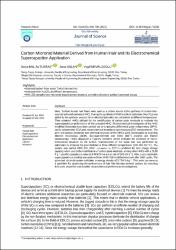| dc.contributor.author | Bal Altuntaş, Derya | |
| dc.contributor.author | Aslan, Sema | |
| dc.contributor.author | Nevruzoğlu, Vagif | |
| dc.date.accessioned | 2021-09-16T10:24:25Z | |
| dc.date.available | 2021-09-16T10:24:25Z | |
| dc.date.issued | 2021 | en_US |
| dc.identifier.citation | Bal Altuntaş, D. , Aslan, S. & Nevruzoğlu, V. (2021). Carbon Microrod Material Derived From Human Hair and Its Electrochemical Supercapacitor Application . Gazi University Journal of Science , 34 (3) , 695-708 . DOI: 10.35378/gujs.712032 | en_US |
| dc.identifier.uri | https://doi.org/10.35378/gujs.712032 | |
| dc.identifier.uri | https://hdl.handle.net/20.500.12809/9540 | |
| dc.description.abstract | Here, Turkish human hair fibers were used as a carbon source at the synthesis of human hair-sourced activated carbons (HHC). During the synthesis of HHCs sodium carbonate (Na2CO3) was added to the synthesis process for an elevated activation by calcination at different temperatures. Then obtained HHCs utilized for the modification of carbon paste electrode to evaluate the supercapacitance performance of this activated HHC. Electrochemical investigation of the HHC modified electrodes have been carried out by employing differential pulse voltammetry (DPV), cyclic voltammetry (CV) and electrochemical impedance spectroscopy (EIS) measurements. The pore and surface properties and chemical structure of the HHCs were investigated by scanning electron microscopy (SEM), Brunauer-Emmett and Teller (BET) analysis and Raman spectroscopy. HHCs displayed a Type-IV isotherm, which indicates the existence of micro-mesoporous structure on the surface. Carbonization of the waste hair was performed by calcination to improve the pore facilities at three different temperatures (200-250-300 degrees C). The sample was named HHC-250 (HHC calcinated at 250 degrees C) exhibited the best charge storage capacity when used at the modification of carbon paste electrode, among other HHCs with a 26.88 F g(-1) specific capacitance value (in 6 M KOH at a scan rate of 100 mV s(-1)). Also, a very attainable supercapacitance stability was achieved from HHC-250 modified electrode after 1000 cycles. The presented electrode system exhibited an energy density of 3.73W h kg(-1). This work can serve as a guideline for optimizing the performance of hair like biomass-derived carbons by matching their pore properties and detailed electrochemical performance investigations. | en_US |
| dc.item-language.iso | eng | en_US |
| dc.publisher | Gazi Üniversitesi | en_US |
| dc.relation.isversionof | 10.35378/gujs.712032 | en_US |
| dc.item-rights | info:eu-repo/semantics/openAccess | en_US |
| dc.subject | Human hair | en_US |
| dc.subject | Supercapacitors | en_US |
| dc.subject | Electrochemical | en_US |
| dc.subject | Application | en_US |
| dc.subject | Carbon | en_US |
| dc.subject | Microrod | en_US |
| dc.title | Carbon Microrod Material Derived from Human Hair and Its Electrochemical Supercapacitor Application | en_US |
| dc.item-type | article | en_US |
| dc.contributor.department | MÜ, Fen Fakültesi, Kimya Bölümü | en_US |
| dc.contributor.authorID | 0000-0001-9796-7311 | en_US |
| dc.contributor.institutionauthor | Aslan, Sema | |
| dc.identifier.volume | 34 | en_US |
| dc.identifier.issue | 3 | en_US |
| dc.identifier.startpage | 695 | en_US |
| dc.identifier.endpage | 708 | en_US |
| dc.relation.journal | Gazi University Journal of Science | en_US |
| dc.relation.publicationcategory | Makale - Uluslararası Hakemli Dergi - Kurum Öğretim Elemanı | en_US |


















